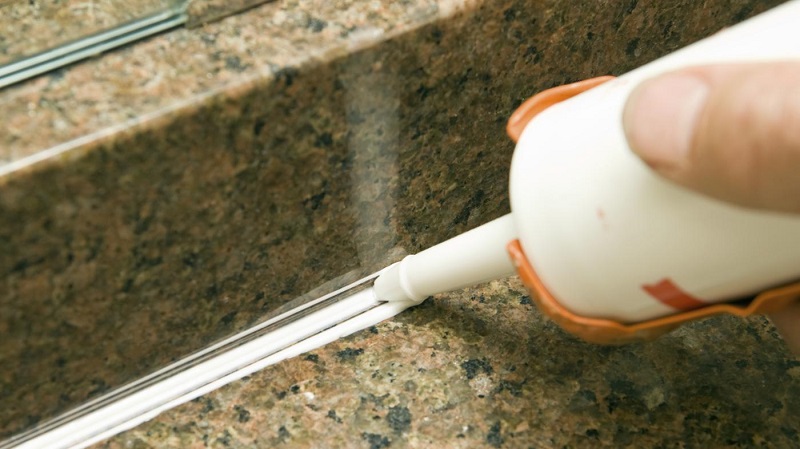Sealants in construction
Sealants are used in construction to prevent fluids and other substances from passing through material surfaces, joints, or openings. They can also prevent the passage of air, sound, dust, insects, and so on, as well as acting as a firestopping component.
Sealants are typically used to close openings between spaces that are too small for other materials such as concrete, timber or mortar to be used. They have a wide range of properties in terms of strength, flexibility, appearance permanence, solubility, corrosion resistance, and so on.
While some sealants have adhesive qualities, they differ from conventional adhesives in that they tend to have lower strength and higher elongation. This means that they can be used more flexibly between substrates with different properties.
Historically, materials such as plant resins, mud, grass and reeds were used as sealants. Glazing putty was first used in the 17th century as a means of sealing window glass into the panes. Sealants were first chemically manufactured in the 1920s, in the form of acrylic, butyl and silicone polymers. Synthetic-polymer-based sealants became widely available for use in construction by the 1960s.
The three basic functions of a sealant are as follows:
- Fill a gap between two or more substrates.
- Form a barrier through which other substances cannot pass.
- Maintain sealing properties for the anticipated lifetime.
These functions can be achieved by matching the most suitable sealant to the substrate materials, i.e. one that will have adequate bonding properties and be flexible enough to tolerate anticipated movement, and so on.
Sealants may have a high viscosity, meaning that they do not flow from where they are applied, or a low viscosity, allowing them to penetrate into a substrate. Anaerobic acrylic sealants are able to cure in the absence of air, whereas surface sealants require air to cure.
Some of the most common types of sealants include:
- Acrylic resins
- Butyl rubber
- Epoxy thermosets
- Expanding foam
- Hot wax
- Latex sealants
- Metal sealants
- Paint sealants
- Polysulfide sealants
- Polyurethane sealants
- Rubber sealants
- Silicone sealant
- Urethane sealants
- Varnish
Sealants are typically applied using a caulk gun with a plunger mechanism. Some of the variations include:
- Stamped-steel caulk gun: The least expensive type, which can be disposed of after use.
- Manual caulk gun: Heavy duty for moderate construction use. Has a strong steel body and cast iron handle.
- Bulk caulk gun: This is used for fast application and is designed to accept sealant supplied in bulk.
- Air-powered caulk gun: Capable of pumping high viscosity sealants at high speed and in large volumes.
In certain circumstances, soldering or welding can be used as alternatives to sealants, although these involve more complex techniques.
[edit] Related articles on Designing Buildings
Featured articles and news
RTPI leader to become new CIOB Chief Executive Officer
Dr Victoria Hills MRTPI, FICE to take over after Caroline Gumble’s departure.
Social and affordable housing, a long term plan for delivery
The “Delivering a Decade of Renewal for Social and Affordable Housing” strategy sets out future path.
A change to adoptive architecture
Effects of global weather warming on architectural detailing, material choice and human interaction.
The proposed publicly owned and backed subsidiary of Homes England, to facilitate new homes.
How big is the problem and what can we do to mitigate the effects?
Overheating guidance and tools for building designers
A number of cool guides to help with the heat.
The UK's Modern Industrial Strategy: A 10 year plan
Previous consultation criticism, current key elements and general support with some persisting reservations.
Building Safety Regulator reforms
New roles, new staff and a new fast track service pave the way for a single construction regulator.
Architectural Technologist CPDs and Communications
CIAT CPD… and how you can do it!
Cooling centres and cool spaces
Managing extreme heat in cities by directing the public to places for heat stress relief and water sources.
Winter gardens: A brief history and warm variations
Extending the season with glass in different forms and terms.
Restoring Great Yarmouth's Winter Gardens
Transforming one of the least sustainable constructions imaginable.
Construction Skills Mission Board launch sector drive
Newly formed government and industry collaboration set strategy for recruiting an additional 100,000 construction workers a year.
New Architects Code comes into effect in September 2025
ARB Architects Code of Conduct and Practice available with ongoing consultation regarding guidance.
Welsh Skills Body (Medr) launches ambitious plan
The new skills body brings together funding and regulation of tertiary education and research for the devolved nation.
Paul Gandy FCIOB announced as next CIOB President
Former Tilbury Douglas CEO takes helm.
UK Infrastructure: A 10 Year Strategy. In brief with reactions
With the National Infrastructure and Service Transformation Authority (NISTA).
























Comments
[edit] To make a comment about this article, click 'Add a comment' above. Separate your comments from any existing comments by inserting a horizontal line.